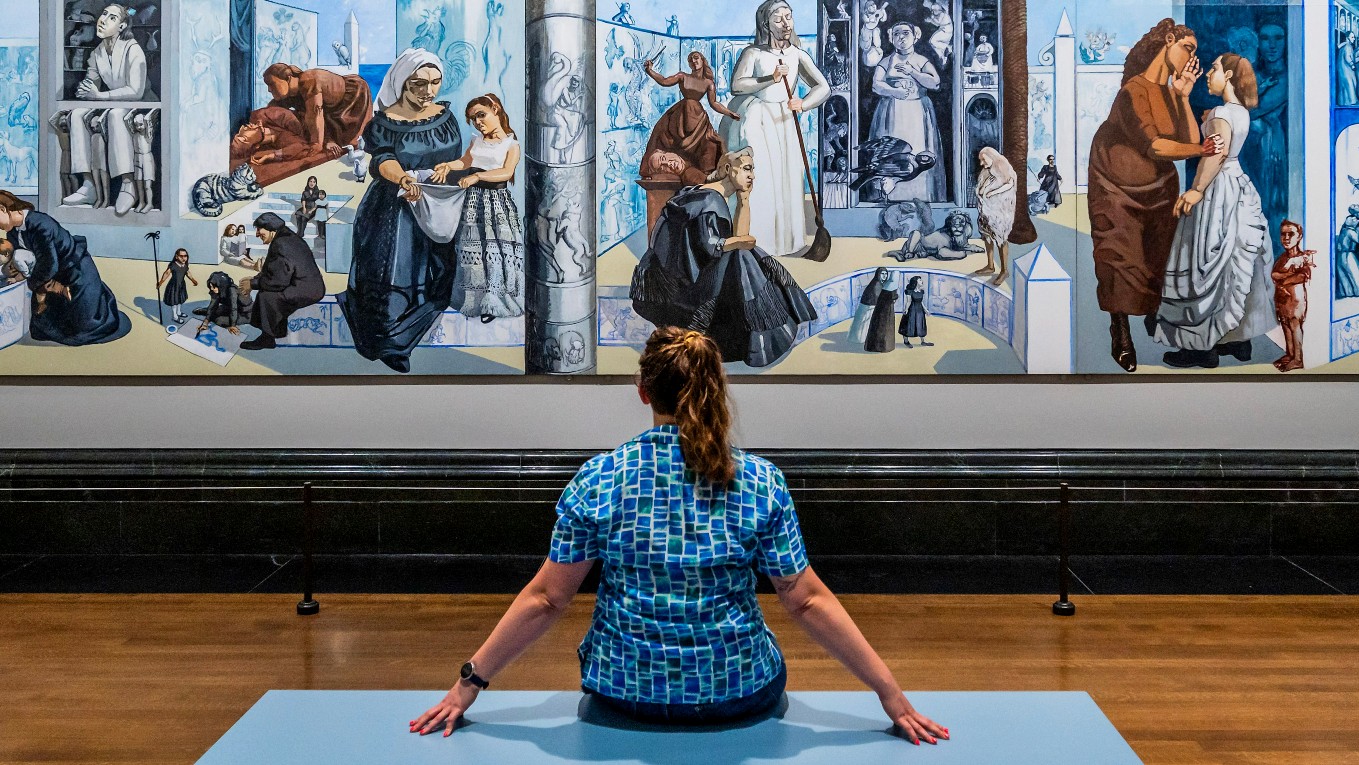Paula Rego: Crivelli’s Garden a ‘triumphant vision of female experience’
Contemporary response to Carlo Crivelli’s The Madonna of the Swallow shown alongside original

When Paula Rego was asked to paint a mural for the dining room of the National Gallery’s Sainsbury Wing in 1990, it “seemed a thoughtless insult”, said Laura Cumming in The Observer. The artist, who died last year aged 87, was renowned for focusing on the kinds of people normally ignored in art. Her work addressed “the plight of women as cooks, cleaners, waitresses and all-round aproned slaves”; surely she “deserved better” than an upmarket canteen.
Yet she took to the task with gusto, resolving to produce a contemporary response to the Carlo Crivelli altarpiece “The Madonna of the Swallow” (c.1491), which depicts the lives of women from biblical history and folklore. The result was “Crivelli’s Garden“, a nine-metre-long mural that incorporates “a dense anthology of stories” from biblical and mythological sources, as well as references to aspects of Rego’s own life. Now, the mural has been brought into the gallery itself, and is being shown alongside the masterpiece that inspired it, for this small, free-to-enter exhibition.
I had always thought of the mural as a “playful work, perfectly judged for its setting in a convivial dining room, full of love for the Renaissance art this museum houses”, said Jonathan Jones in The Guardian. Yet here it has been cast as a “Major Masterpiece of Radical Art”. In the exhibition catalogue, Rego’s son, Nick Willing, explains that she saw the National Gallery as a place that almost solely reflected the male experience, and she had set out to challenge “the patriarchy to examine itself”.
The Week
Escape your echo chamber. Get the facts behind the news, plus analysis from multiple perspectives.

Sign up for The Week's Free Newsletters
From our morning news briefing to a weekly Good News Newsletter, get the best of The Week delivered directly to your inbox.
From our morning news briefing to a weekly Good News Newsletter, get the best of The Week delivered directly to your inbox.
The trouble is that while Rego could be “a formidable”, “psychologically acute artist”, her interest in fairy tales and folklore sometimes edged her into feyness – and it is that side of her that we see here. “Crivelli’s Garden” bursts “with incident and imagination”; blue Portuguese tiles teem with images from myths and Bible stories “in which women feature powerfully”. But it is so “high on storytelling” that the effect is confusing, and there is a descent into whimsy. Crivelli’s altarpiece, by contrast, “bristles with wit, life and danger”. Enjoyable as Rego’s piece is, it pales somewhat by comparison.
On the contrary, “this juxtaposition of two supreme narrative paintings” marks a “marvellous moment”, said Jackie Wullschläger in the Financial Times, one that “celebrates art’s continuities, dialogues and reinventions”. Rego’s work is both “a magnificent decorative piece” and a “triumphant vision of female experience”. Look closely at the pictures within a picture, and you can read the mural as a series of exchanges, between Rego and Crivelli, and “more broadly” with the gallery’s collection. References to paintings within it abound, and some of her models were female members of the museum’s staff. “Crivelli’s Garden” is a work years ahead of its time. Seeing it afresh “raises our sense of Rego’s originality and impact higher than ever”.
National Gallery, London WC2 (020 7747 2885). Until 29 October. Free entry. nationalgallery.org.uk
A free daily email with the biggest news stories of the day – and the best features from TheWeek.com
-
 Wilde Cambridge: home-away-from-home in a prime city spot
Wilde Cambridge: home-away-from-home in a prime city spotThe Week Recommends This laid-back aparthotel is the perfect base for a weekend of exploring
-
 The best alcohol-free alternatives for Dry January
The best alcohol-free alternatives for Dry JanuaryThe Week Recommends Whether emerging from a boozy Christmas, or seeking a change in 2026, here are some of the best non-alcoholic beers, wines and spirits to enjoy
-
 A lemon-shaped exoplanet is squeezing what we know about planet formation
A lemon-shaped exoplanet is squeezing what we know about planet formationUnder the radar It may be made from a former star
-
 The ultimate films of 2025 by genre
The ultimate films of 2025 by genreThe Week Recommends From comedies to thrillers, documentaries to animations, 2025 featured some unforgettable film moments
-
 Into the Woods: a ‘hypnotic’ production
Into the Woods: a ‘hypnotic’ productionThe Week Recommends Jordan Fein’s revival of the much-loved Stephen Sondheim musical is ‘sharp, propulsive and often very funny’
-
 The best food books of 2025
The best food books of 2025The Week Recommends From mouthwatering recipes to insightful essays, these colourful books will both inspire and entertain
-
 Art that made the news in 2025
Art that made the news in 2025The Explainer From a short-lived Banksy mural to an Egyptian statue dating back three millennia
-
 Nine best TV shows of the year
Nine best TV shows of the yearThe Week Recommends From Adolescence to Amandaland
-
 Winter holidays in the snow and sun
Winter holidays in the snow and sunThe Week Recommends Escape the dark, cold days with the perfect getaway
-
 The best homes of the year
The best homes of the yearFeature Featuring a former helicopter engine repair workshop in Washington, D.C. and high-rise living in San Francisco
-
 Critics’ choice: The year’s top 10 movies
Critics’ choice: The year’s top 10 moviesFeature ‘One Battle After Another’ and ‘It Was Just an Accident’ stand out